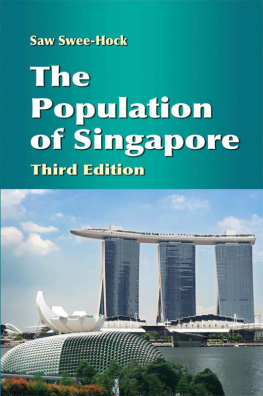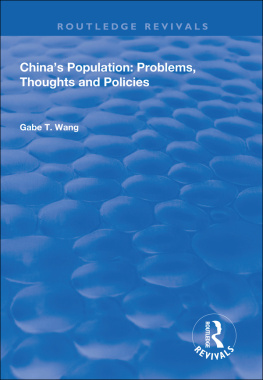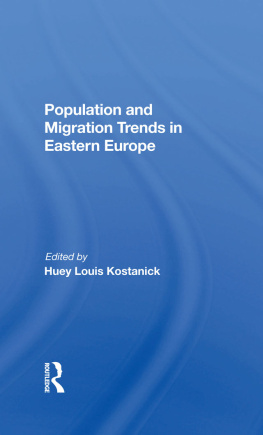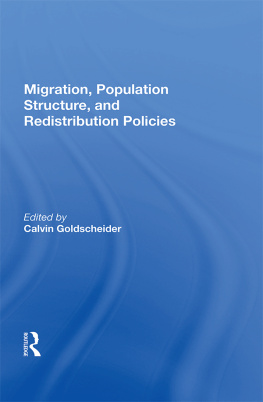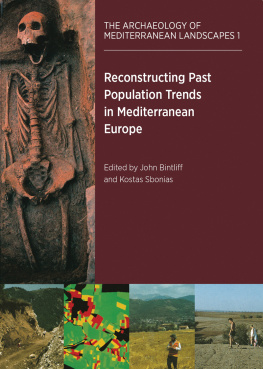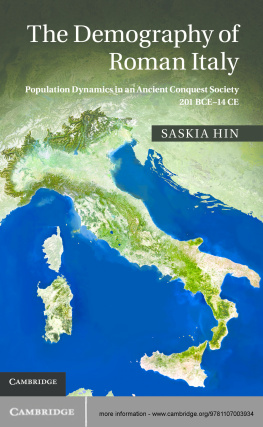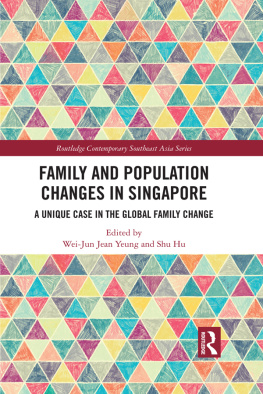The
Population
of Singapore
Third Edition
The Institute of Southeast Asian Studies (ISEAS) was established as an autonomous organization in 1968. It is a regional centre dedicated to the study of socio-political, security and economic trends and developments in Southeast Asia and its wider geostrategic and economic environment.
The Institutes research programmes are the Regional Economic Studies (RES, including ASEAN and APEC), Regional Strategic and Political Studies (RSPS), and Regional Social and Cultural Studies (RSCS).
ISEAS Publishing, an established academic press, has issued almost 2,000 books and journals. It is the largest scholarly publisher of research about Southeast Asia from within the region. ISEAS Publishing works with many other academic and trade publishers and distributors to disseminate important research and analyses from and about Southeast Asia to the rest of the world.

First published in Singapore in 2012 by ISEAS Publishing
Institute of Southeast Asian Studies
30 Heng Mui Keng Terrace
Pasir Panjang
Singapore 119614
E-mail:
Website:
All rights reserved. No part of this publication may be reproduced, stored in a retrieval system, or transmitted in any form or by any means, electronic, mechanical, photocopying, recording or otherwise, without the prior permission of the Institute of Southeast Asian Studies.
2012 Institute of Southeast Asian Studies, Singapore
First Edition 1999
Second Edition 2007
Third Edition 2012
The responsibility for facts and opinions in this publication rests exclusively with the author and his interpretations do not necessarily reflect the views or the policy of the publisher or its supporters.
ISEAS Library Cataloguing-in-Publication Data
Saw, Swee-Hock, 1931
The population of Singapore.
3rd ed.
1. SingaporePopulation policy.
2. SingaporePopulation.
3. DemographySingapore.
I. Title.
HB3645 A3S271 2012 2012
E-ISBN: 978-981-4459-14-3
Typeset by International Typesetters Pte Ltd
Printed in Singapore by Oxford Graphic Printers Pte Ltd
Contents
The city-state of Singapore, with a small cosmopolitan population, is well known for its accomplishments in many areas of social and economic development brought about by a strong and stable government. Among the more significant characteristics are the clean and crime-free environment, the remarkable public housing programme, the air transport system centred on a first-rate airport and national airline, the world-class seaport, and the high standard of living. The per capita income was estimated to reach US$32,810 in 1997, higher than that recorded for Australia, Hong Kong, the United States, the United Kingdom, Germany, and many European countries. In the field of demography, the most prominent achievements are the effective population control programme and the rapid decline in fertility to replacement level in 1975. These two characteristics, together with other major features of the population, are discussed in considerable detail in this book.
It has always been my fervent desire to incorporate my research findings on the different aspects of Singapores demographics into a single cohesive work. Not surprisingly, this ambitious project has taken a long time to realize. Pressure of work prior to my retirement from academia did not permit me to make any sustained effort to prepare the manuscript, and intensive writing could only be realized during my study leave spent in the Department of Statistics at the University of Hong Kong in 1991, and in Wolfson College, University of Cambridge, in the following year. Thereafter, progress on the manuscript was delayed further by the late release of the results of the 1990 Population Census. In giving the finishing touches to the manuscript in the late nineties, I took the opportunity to include whatever data that were pertinent and available for the years up to 1997 to supplement the census data. The final product incorporated in this book has been carefully designed to meet its overall objective of presenting a comprehensive and up-to-date account of population trends and patterns in Singapore.
In the preparation of this book I was fortunate to receive the assistance of many organizations and individuals. In particular, I would like to mention the excellent facilities offered at the National University of Singapore, the University of Hong Kong, and the University of Cambridge. I am greatly indebted to my wife, Cheng Siok Hwa, for her comments on the manuscript. My grateful thanks go to Professor Chia Siow Yue, Director of the Institute of Southeast Asian Studies, for her encouragement. Needless to say, any opinions and shortcomings in the book are entirely my own.
Saw Swee-Hock
June 1997
The original edition of this book on The Population of Singapore presents an analysis of population trends and patterns in Singapore in eleven chapters covering the period from its foundation in the early nineteenth century to around the year 1997. In designing the second edition, I have expanded the book by increasing the number of chapters to thirteen and by including data, particularly those from the 2000 Population Census and the 2005 General Household Survey, that have been made available up to 2005, or even 2006 in some instances. The old chapter on Population Control has been split into two, one entitled Family Planning, Abortion and Sterilisation and the other Fertility Policies and Programmes. A new chapter on the very current topic, Immigration Policies and Programmes, has been added. The last chapter on Future Population Trends incorporates the results of my latest projection of the resident population and, for the first time, the resident labour force. As for the other chapters, they have been updated by including materials that have been made available up to the year 2006 or so. Overall, the changes have resulted in a book that is clearly more current and comprehensive.
In preparing the second edition of the book, I have benefited from the valuable assistance of many organisations and individuals. My thanks go to the numerous government organisations for supplying me with the necessary materials and statistics. My research has been greatly facilitated by the assistance and conducive facilities offered at the London School of Economics Library, the National University Library, and the Institute of Southeast Asian Studies. I wish to thank Ambassador K Kesavapany, Director of ISEAS, for his generous hospitality and Mrs Triena Ong, Managing Editor of ISEAS Publications Unit, for bringing out this edition expeditiously. I wish to reiterate that any opinions and shortcomings are entirely my own.
Saw Swee-Hock
June 2007
The third edition of this book has included all the materials that have been made available since the previous edition was published in 2006. The statistics from the 2005 General Household Survey have been completely replaced with the more comprehensive and reliable data made available from the latest Census of Population conducted in June 2010. Other statistics used in the book were also updated, up to the year 2010 in most cases. Apart from updating the figures in the various chapters, new developments concerning the population of Singapore have been incorporated in these chapters. An important change refers to the computation of a new set of population and labour force projections included in the last chapter.
In preparing the present edition of the book I have again benefited from the assistance I received from the various organizations mentioned in the previous prefaces. I wish to thank Ambassador Tan Chin Tiong, Director of ISEAS, for his support and encouragement and Mrs Triena Ong, Managing Editor of ISEAS Publication Init, for bringing out this edition expenditiously. I wish to emphasize again that any opinions and shortcomings in the book are entirely my own.
Next page
